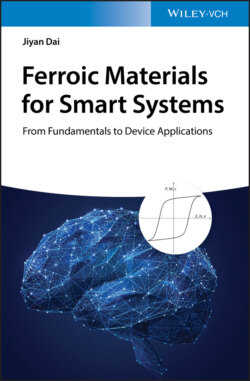Читать книгу Ferroic Materials for Smart Systems - Jiyan Dai - Страница 10
1.1 Smart System
ОглавлениеA smart system, such as a self‐driving car or remote‐control aircraft, is a system that relies on sensors and actuators to realize instant feedback of controlled variables (CVs) such as speed, height, etc. The basic component of a smart system usually contains sensors, actuators, and control system. An intelligent smart system needs large amount of data processing and memories, while ferromagnetic and ferroelectric materials have been implemented in realizing non‐volatile memristors. Beyond that, memories based on ferroelectric thin films may also find application in electronic synapses as building blocks toward building ANN.
As an example, a smart system of remote control copter relying on proportional–integral–derivative (PID) feedback control system is shown in Figure 1.3. PID is a three‐order feedback control system that has been widely used in auto driving vehicles and auto‐pilot airplanes to make the dynamic system operate smoothly or being stable during video imaging. Equation (1.1) illustrates the mechanism of PID control where three terms of proportional gain (P), integral gain (I), and derivative feedback (D) can provide instant response to cure the error (E) between the set point (speed of vehicle or height of the copter) and controlled variable (CV):
(1.1)
Figure 1.3 (a) Photo of a remote control copter and (b) diagram of a PID feedback control system where sensors and actuators are implemented.
In this feedback control system, we can find applications of ferroic materials, for example, piezoelectric‐based gyroscope, surface acoustic wave device for wireless communication, and ferroelectric‐based infrared detector. In gyroscope, rotation and acceleration can be sensed by measuring induced voltage generated by piezoelectric effect; a surface acoustic wave device based on piezoelectric effect is used for communication band selection; and a ferroelectric‐based infrared detector can be used as an intruder sensor making the copter able to find people for rescue mission. Figure 1.4 shows the finite element modeling (FEM) simulation of three resonant motions in a Pb(Zrx,Ti1−x)O3 (PZT)‐based gyroscope and photo of a fabricated gyroscope (Chang and Chen 2017).
Sensors: Devices that can “sense” a change in some physical characteristics and perform an electrical input function are commonly called sensors. For example, a strain sensor converts mechanical strain into electrical signal.
Actuators: Devices that perform an output function are generally called actuators. An actuator can be utilized to control some external moduli or output mechanical movement such as ultrasonic wave. For example, an atomic force microscope (AFM) uses piezoelectric actuators to realize scanning along three directions.
Transducers: Both sensors and actuators are collectively known as transducers because they are used to convert energy of one kind into energy of another kind. Transducers can be used to sense a wide range of different energy forms such as movement, electrical signals, thermal or magnetic energy, etc. The type of input or output transducers being used really depends on the type of signal or process being “sensed” or “controlled,” but we can define a transducer as a device that converts one physical quantity into another.
Figure 1.4 FEM simulations of three resonant motions in a PZT‐based gyroscope and photo of a fabricated gyroscope.
Source: Adapted from Chang and Chen (2017).
A smart system needs sensors and actuators to realize the sensing functions such as distance, movement, and acceleration as well as actions. These sensors and actuators use smart materials to realize the conversion between different energies and moduli to electrical signals such as voltage, current, and capacitance. Of course, many sensor devices are made of semiconductors such as the FET, but this is not the focus of this book.
“Smart material” is a very large concept, in fact, there is no stupid material (a joke), i.e. all materials are smart in some way since they all have their own properties and response to external stimuli. But in this book, we restrict the “smart materials” to those materials with “ferroic” characteristics. We focus on basic physics, materials science, structures, devices, and applications of ferroic materials for smart systems. The ferroic materials are usually classified as possessing one of the followings based on coupling of stimuli:
1 (i) Ferroelectric, which is also piezoelectric when electromechanically coupled and pyroelectric when thermoelectrically coupled.
2 (ii) Ferromagnetic, which is also magnetostrictive when magnetomechanically coupled.
3 (iii) Ferroelastic, which also includes shape memory when thermomechanically coupled.
Among these ferroics, we can see that strain, electric polarization and magnetization, and their interplay or coupling are involved. We call a material as ferroic material if it possesses at least one of the properties of ferroelectric, ferromagnetic and ferroelastic.
If we look at the diagram shown in Figure 1.5, we can see that the coupling and interplay between electricity, mechanics, magnetism, heat, and optics result in many smart functions, such as ferroelectric, piezoelectric, pyroelectric, ferromagnetic, electromechanical, etc. One book cannot cover all of them, but those belong to ferroic materials and devices especially in the form of thin films will be extensively introduced in this book. Before going into details, some application examples of ferroic materials in smart systems are given in this chapter.
Figure 1.5 Diagram showing coupling between different moduli and the clarification of smart materials.
